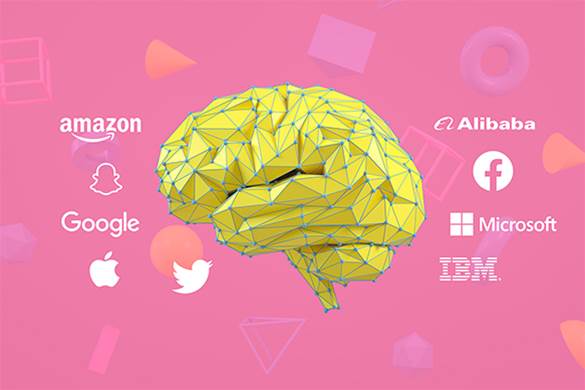The popularity of generative AI has skyrocketed over the past eight months ever since ChatGPT made waves in November 2022.

The novelty of AI generated responses and getting paragraphs of information in merely an instant has turned the corporate world upside down.
Announcements in AI investment have filled up news feeds and more organisations are turning to this technology to embed it within their business functions.
And now, the technology giants want a piece of the action too with the majority of them making some form of investment or announcement surrounding their AI investment.
Some of the giants are throwing millions of dollars at their AI investment creating centres for excellence, others are testing the technology on parts of their business and some are keeping their lips sealed on their developments.
Here is a non-comprehensive and non-exhaustive breakdown of which technology giants are using generative AI and what they are doing with the technology.
Microsoft
If there was a competition on who is winning the generative AI race, Microsoft might possibly be in the lead. Microsoft has had a four-year-long partnership with OpenAI, owner of ChatGPT, and earlier this year doubled down on that partnership with a “multi-billion, multi-year agreement”. Its reportedly US$10 billion, but no definite figure has been disclosed.
Microsoft has embedded the generative AI technology into a foray of its products including Azure, Bing, the Microsoft store, Microsoft Edge and Office 365.
In March, Microsoft launched Microsoft 365 Copilot, using large language models (LLM) embedded into the entire Microsoft 365 suite it “helps” workers be more productive. It also has a chat function similar to ChatGPT where users can ask for work-related prompts.
Google has been heads down, bums up in terms of getting out AI products ever since competitors Microsoft and OpenAI became popular. In early February this year, both announced generative AI in their search products within days of each other. Some pundits went far as to say Microsoft had the edge (pardon the pun) over Google.
Google has Bard, its version of ChatGPT, which it launched in February this year. Similar to Microsoft, it will be embedded into Google Search (a when not if) but it is currently still in beta mode.
The search giant will be embedding this technology into its various products – Gmail, Drive, Docs – in the near future.
AWS
Only a few weeks ago, Amazon Web Services (AWS) announced the AWS generative AI innovation centre to help its customers build and deploy generative AI solutions.
AWS invested US$100 million into the program which it said will “connect AWS AI and machine learning (ML) experts with customers around the globe to help them envision, design, and launch new generative AI products, services, and processes”.
Amazon
Amazon hasn't officially announced anything generative AI-related for its core product Amazon.com. However, CNBC reported that it is testing a generative AI tool for summarising reviews on its shopfront.
Amazon confirmed it is testing the feature and didn't comment on anything else.
Adobe
Adobe Firefly is the company’s generative AI product that it released in May this year.
Similar to an AI art platform like DeepAI or Midjourney, users on Firefly put in their prompts and the AI creates an image based on that.
Firefly also brings in generative fill to remove or paint in new objects, text effects and generative recolour.
The platform is still in beta mode.
IBM
In May, IBM unveiled its centre of excellence for generative AI.
An organisation already working within the AI space, the new centre of excellence will have more than 1,000 people with specialised generative AI knowledge to help IBM’s clients “drive productivity” in IT operations and business processes.
It will also soon release watsonx.ai, its enterprise studio for AI builders, to help organisations integrate AI into their business processes.
Apple
Apple has been mum on its generative AI journey. But some reporters at TechCrunch saw that the iPhone creator was on the hunt for generative AI. Apple Watch this space.
Meta
Meta has two generative AI-based products at the moment, and no consumer-facing tools, yet.
The first is a sandbox tool for advertisers, which optimises images and gives advertisers the best engagement from their intended audience. This is currently being tested in the US and gradually rolling out globally.
Secondly, is Voicebox, an AI voice generation model that helps with audio editing, sampling, styling and some translations (English, French, Spanish, German, Polish, and Portuguese). However, it is currently only available to researchers.
Alibaba
The Chinese e-commerce giant in April showcased its venture into generative AI with its LLM, Tongyi Qianwen.
According to the company, it will be “integrated across Alibaba’s various businesses to improve user experience in the near future”.
The LLM will be deployed first on DingTalk, the company’s digital collaboration workplace and Tmall Genie, an application development platform.
Tongyi Qianwen is currently in beta testing.
Snap
Even Snap has gotten in on the generative AI action with its AI-powered chatbot, My AI. The company said it is a tool for “creativity and connection”.
The social media app said in June more than 150 million users had sent over 10 billion messages to the chatbot.
In June, the company announced it developed a text input to image generation for mobile users called SnapFusion. It is still in its infancy so it is unavailable for consumers at this point in time.
While Twitter hasn’t officially launched any generative AI products, Business Insider reported in April that Elon Musk was in the throws of a LLM project at the social media company.
Stay tuned.


_(22).jpg&h=140&w=231&c=1&s=0)
_(20).jpg&h=140&w=231&c=1&s=0)

.png&h=140&w=231&c=1&s=0)



_(26).jpg&w=100&c=1&s=0)

 iTnews Executive Retreat - Security Leaders Edition
iTnews Executive Retreat - Security Leaders Edition












_(1).jpg&h=140&w=231&c=1&s=0)



